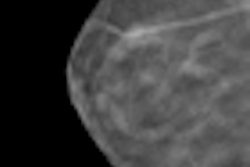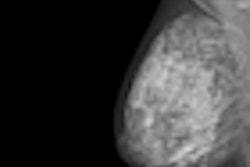Two-view digital breast tomosynthesis (DBT) performs better than digital mammography in terms of diagnostic accuracy -- but only for less-experienced readers, according to a study published online in Radiology. It does reduce recall rates across the board, though, say researchers from the U.K. and Sweden.
Tomosynthesis has been shown to improve specificity and reduce recall rates when used in addition to conventional mammography. But radiation dose levels are a concern, wrote Dr. Matthew Wallis, of Cambridge University Hospitals NHS Foundation Trust in the U.K., and colleagues. Wallis' group explored the use of single-view tomosynthesis as compared to two-view tomosynthesis (Radiology, January 24, 2012).
"Our results suggest that two-view tomosynthesis will improve diagnostic accuracy for the less-experienced reader and reduce recall rates, but this needs to be tested in real-life studies with economic analysis before widespread introduction to population screening can be [considered]," Wallis and colleagues wrote.
The researchers used a digital breast tomosynthesis system that is commercially available in Europe (MicroDose D40, Sectra, now marketed by Philips Healthcare), and compared the images to those acquired on 2D digital mammography systems (Senograph DS or Senograph Essential, GE Healthcare).
The study included 130 women; 64 had abnormal images (40 with cancer and 24 with benign lesions) and 66 had normal images. Two sets of 10 readers (18 radiologists and two radiographers from national breast screening programs in the U.K. and Sweden) interpreted the exams.
The readers had experience reading breast images ranging from 2.5 years to 25 years (average, 10 years). The first set of readers interpreted two-view tomosynthesis images as compared to 2D mammograms, while the second set of readers interpreted single-view tomosynthesis images as compared to 2D mammograms.
Wallis' team found that two-view tomosynthesis performed better than 2D mammography for diagnostic accuracy (area under the curve = 0.851 versus 0.772, respectively) and also when the analysis was repeated according to lesion type (masses and microcalcifications).
When the team conducted the comparison based on reader experience, this improvement in diagnostic accuracy for two-view tomosynthesis compared to mammography was only evident in the group of readers who had less than 10 years of experience.
"We have shown that two-view tomosynthesis benefits the least experienced readers, in contradiction to [other research that suggests] all radiologists benefit from the addition of tomosynthesis to 2D mammography regardless of prior experience," Wallis and colleagues wrote.
The study showed no significant different between 2D mammography and single-view tomosynthesis, regardless of reader experience or lesion type. Average reading times ranged from 124 seconds (two-view tomosynthesis) to 97 seconds (single-view tomosynthesis) and 67 seconds (mammography).
Compared with 2D mammography, tomosynthesis reduced recall rates, which the group measured as the number of cases recalled versus the total number of cases for both two-view and single-view tomosynthesis. Two-view tomosynthesis saw a reduction of 11% (recall rate of 0.53 for mammography and 0.47 for tomosynthesis), and single-view tomosynthesis had a reduction of 9.5% (recall rate of 0.63 for mammography and 0.57 for tomosynthesis).
The researchers debated the prospect of whether it would be advisable to perform screening mammography with single-view tomosynthesis, given that the technique performed at the same level as mammography and users would be able to employ half the radiation dose. But caution should be taken, according to the group.
"A number of smaller lesions were not visible on the single-view projection because they were not included on the image due to either their position in the breast or to poor technique, meaning that it would be important to test this proposition in a large real-life prospective study to ensure that equity [between the two modalities] was maintained," they wrote.
| The study was funded by a grant from the European Union, while Sectra supplied the mammography equipment. |



















